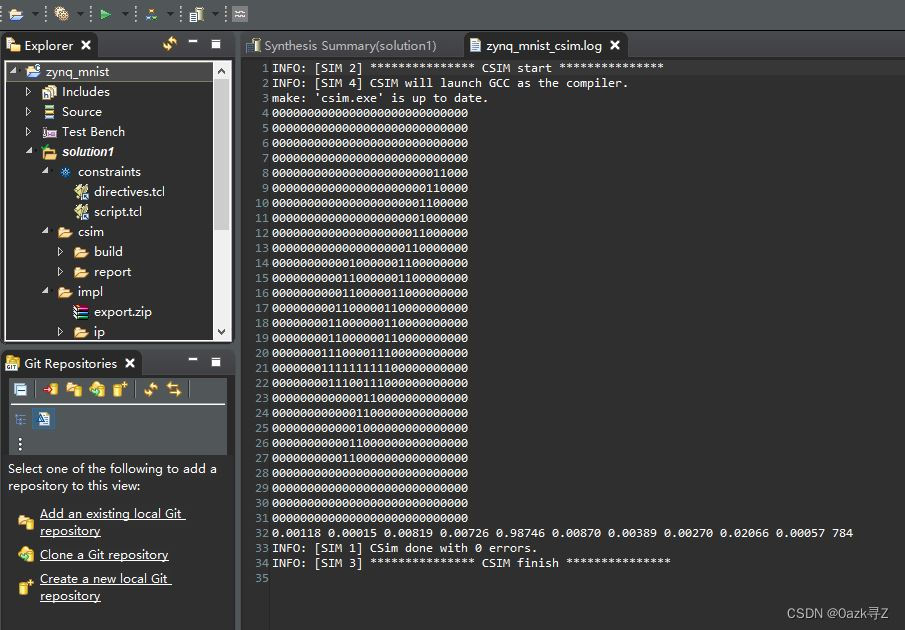阅读量:0
用正点原子ZYNQ7020实现mnist数据集的前向推理
项目流程说明
目前的神经网络并不适合在低功耗处理器上进行训练,但是在fpga中单纯用于任务处理还是有点搞头的。。本项目即实现了最最简单网络模型在FPGA上用于识别最最简单手写数字的tiny级任务。
一、生成预先计划的图片数据文件
从网络下载的mnist数据集包括两个csv数据文件,训练集和测试集,需要将其转换为所需的数据文件供PS端加载。
- 原始文件 :网络下载的mnist数据集包括两个csv数据文件,训练集和测试集。每个文件中的每一行有785个数据,第一列为标记,之后的是784个0~255之间的像素值;
- 需要用数据处理程序读取源文件的某一行并生成 具有特定分隔符 的数据文件;
- 仅作为测试用,一个文件只保存一幅图像数据即可,可以随机多生成几个文件,一是防止网络模型识别错误的小概率事件发生,二是相互对照便于比较PS端程序的稳定性;
- 数据均转化为0~1之间的浮点数,每个数据为4字节;
- 示例程序中使用python脚本读取csv文件,随机生成了5个数据文件。上代码:
import csv import random def normalize_pixel_value(value): """Normalize the pixel value to be between 0 and 1.""" return float(value) / 255.0 def read_random_row_from_csv(file_path): """Read a random row between 1 and 10 from the CSV file and return as a list of normalized floats, excluding the first value.""" with open(file_path, newline='') as csvfile: reader = list(csv.reader(csvfile)) random_row_index = random.randint(1, 10) - 1 # Randomly select a row index between 0 and 9 (corresponding to rows 1 to 10) random_row = reader[random_row_index] # Get the selected row normalized_data = [normalize_pixel_value(value) for value in random_row[1:]] # Skip the first value and normalize the rest return normalized_data def write_data_to_file(file_path, data): """Write the data to a file with ',\n\r' as the separator.""" with open(file_path, 'w') as file: for value in data: file.write(f"{value},\n\r") def main(): # Read a random row between 1 and 10 from src.csv normalized_data = read_random_row_from_csv('data/mnist_test.csv') # Write the normalized data to b.dat write_data_to_file('out/a05.dat', normalized_data) if __name__ == "__main__": main() 二、搭建模型,训练神经网络,得到权重参数
- 搭建的神经网络为两个隐藏层、一个输入层、一个输出层,均为全连接网络层线性层,即y = A * x + B ;
- 输入层节点数为784,隐藏层节点数为64、32,输出层节点数为10;
- 共有3个网络权重文件和3个偏置数据文件,在网络训练完成后需要各个单独保存;
- 这6个网络数据文件需要固化在PL端的IP核中;
- 示例程序中使用python脚本实现了上述功能。上代码:
# Importing necessary libraries import numpy import scipy.special import matplotlib.pyplot # Defining the neural network class class neuralNetwork: # Initializing the neural network def __init__(self, inputnodes, hiddennodes1, hiddennodes2, outputnodes, learningrate): self.inodes = inputnodes self.hnodes1 = hiddennodes1 self.hnodes2 = hiddennodes2 self.onodes = outputnodes self.lr = learningrate # Weight initialization self.wih = numpy.random.normal(0.0, pow(self.inodes, -0.5), (self.hnodes1, self.inodes)) self.whh = numpy.random.normal(0.0, pow(self.hnodes1, -0.5), (self.hnodes2, self.hnodes1)) self.who = numpy.random.normal(0.0, pow(self.hnodes2, -0.5), (self.onodes, self.hnodes2)) # Bias initialization self.bih = numpy.random.normal(0.0, pow(self.inodes, -0.5), (self.hnodes1, 1)) self.bhh = numpy.random.normal(0.0, pow(self.hnodes1, -0.5), (self.hnodes2, 1)) self.bho = numpy.random.normal(0.0, pow(self.hnodes2, -0.5), (self.onodes, 1)) # Activation function is the sigmoid function self.activation_function = lambda x: scipy.special.expit(x) # Training the neural network def train(self, inputs_list, targets_list): inputs = numpy.array(inputs_list, ndmin=2).T targets = numpy.array(targets_list, ndmin=2).T hidden_inputs1 = numpy.dot(self.wih, inputs) + self.bih hidden_outputs1 = self.activation_function(hidden_inputs1) hidden_inputs2 = numpy.dot(self.whh, hidden_outputs1) + self.bhh hidden_outputs2 = self.activation_function(hidden_inputs2) final_inputs = numpy.dot(self.who, hidden_outputs2) + self.bho final_outputs = self.activation_function(final_inputs) output_errors = targets - final_outputs hidden_errors2 = numpy.dot(self.who.T, output_errors) hidden_errors1 = numpy.dot(self.whh.T, hidden_errors2) self.who += self.lr * numpy.dot((output_errors * final_outputs * (1.0 - final_outputs)), numpy.transpose(hidden_outputs2)) self.bho += self.lr * numpy.sum(output_errors * final_outputs * (1.0 - final_outputs), axis=1, keepdims=True) self.whh += self.lr * numpy.dot((hidden_errors2 * hidden_outputs2 * (1.0 - hidden_outputs2)), numpy.transpose(hidden_outputs1)) self.bhh += self.lr * numpy.sum(hidden_errors2 * hidden_outputs2 * (1.0 - hidden_outputs2), axis=1, keepdims=True) self.wih += self.lr * numpy.dot((hidden_errors1 * hidden_outputs1 * (1.0 - hidden_outputs1)), numpy.transpose(inputs)) self.bih += self.lr * numpy.sum(hidden_errors1 * hidden_outputs1 * (1.0 - hidden_outputs1), axis=1, keepdims=True) # Querying the neural network def query(self, inputs_list): inputs = numpy.array(inputs_list, ndmin=2).T hidden_inputs1 = numpy.dot(self.wih, inputs) + self.bih hidden_outputs1 = self.activation_function(hidden_inputs1) hidden_inputs2 = numpy.dot(self.whh, hidden_outputs1) + self.bhh hidden_outputs2 = self.activation_function(hidden_inputs2) final_inputs = numpy.dot(self.who, hidden_outputs2) + self.bho final_outputs = self.activation_function(final_inputs) return final_outputs # Method to save weights and biases to file def save_parameters(self, filename_prefix): numpy.savetxt(f"out/{filename_prefix}_wih.dat", self.wih, delimiter=",", newline=",\n\r") numpy.savetxt(f"out/{filename_prefix}_whh.dat", self.whh, delimiter=",", newline=",\n\r") numpy.savetxt(f"out/{filename_prefix}_who.dat", self.who, delimiter=",", newline=",\n\r") numpy.savetxt(f"out/{filename_prefix}_bih.dat", self.bih, delimiter=",", newline=",\n\r") numpy.savetxt(f"out/{filename_prefix}_bhh.dat", self.bhh, delimiter=",", newline=",\n\r") numpy.savetxt(f"out/{filename_prefix}_bho.dat", self.bho, delimiter=",", newline=",\n\r") def main(): input_nodes = 784 hidden_nodes1 = 64 hidden_nodes2 = 32 output_nodes = 10 learning_rate = 0.16 n = neuralNetwork(input_nodes, hidden_nodes1, hidden_nodes2, output_nodes, learning_rate) training_data_file = open("data/mnist_train.csv", 'r') training_data_list = training_data_file.readlines() training_data_file.close() epochs = 15 for e in range(epochs): for record in training_data_list: all_values = record.split(',') inputs = (numpy.asfarray(all_values[1:]) / 255.0 * 0.99) + 0.01 targets = numpy.zeros(output_nodes) + 0.01 targets[int(all_values[0])] = 0.99 n.train(inputs, targets) # Save the weights and biases after training n.save_parameters("mnist") test_data_file = open("data/mnist_test.csv", 'r') test_data_list = test_data_file.readlines() test_data_file.close() scorecard = [] for record in test_data_list: all_values = record.split(',') correct_label = int(all_values[0]) inputs = (numpy.asfarray(all_values[1:]) / 255.0 * 0.99) + 0.01 outputs = n.query(inputs) label = numpy.argmax(outputs) scorecard.append(1 if label == correct_label else 0) scorecard_array = numpy.asarray(scorecard) print("performance = ", scorecard_array.sum() / scorecard_array.size) if __name__ == "__main__": main() 三、HLS设计
- 加载训练好的神经网络数据文件,可以在代码中添加预编译: #inculde 文件 指令,HLS支持。。。
- HLS需要用 c++ 代码实现线性层和激活层的运算,主要为for循环;
- 添加约束和优化指令,主要是指定输入输出端口为bram总线型;最好关闭一些for循环的流水线,否则dsp资源不够用;
- 编写测试文件对源文件进行调试,减少返工。。
- 示例程序中上述功能测试已经过运行验证 。

四、Vivado设计
- 导入生成的IP核,正点原子的板卡不要忘了修改makefile文件;
- 需要用到的外设有 DDR、UART、SD ,另外再添加上bram控制器和生成器,然后添加自定义的网络模型IP核,IP核不用更改内部参数设置,分配合适的地址和空间即可;
- 分析综合布局布线生成bit文件并导出硬件平台信息;
- 示例程序中上述功能测试已经过运行验证。
五、Vitis设计
- 导入硬件平台信息,导入板级包支持Fat系统文件操作;
- 编写c代码源文件,主要是从SD卡读取图片信息,然后送入网络模型入口,然后从网络模型出口处读取数据,经过串口打印显示;
- 注意内存地址的读写容易出问题
从而陷入异常无限循环无法自拔。。 - 示例程序中上述功能测试已经过运行验证,其识别效果并不稳定,时好时坏,暂未解决。。。。(不过可以肯定的是PL的IP核是有用的,基本目的已经达成。)
- 后续可优化的部分还有,额,很多很多,如果有哪位大佬有相关的优化想法和方法或者相关问题的解决方案,还望一起交流啊~,先谢了
程序说明
本文所使用的源代码和模型结构大部分基于这篇文章进行微调(换了个马甲):
如何从零开始将神经网络移植到FPGA(ZYNQ7020)加速
参考贴文链接:: 如何从零开始将神经网络移植到FPGA(ZYNQ7020)加速
本项目代码已经发布到Github,若需要请自取,链接地址 ::zynq7020_mnist 项目文件
